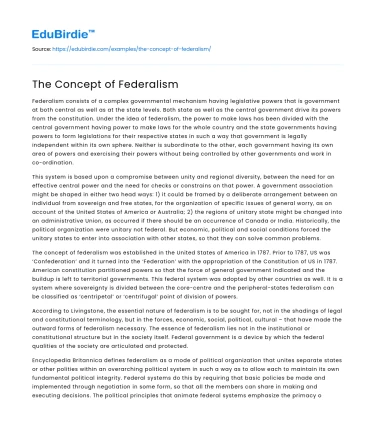Federalism consists of a complex governmental mechanism having legislative powers that is government at both central as well as at the state levels. Both state as well as the central government drive its powers from the constitution. Under the idea of federalism, the power to make laws has been divided with the central government having power to make laws for the whole country and the state governments having powers to form legislations for their respective states in such a way that government is legally independent within its own sphere. Neither is subordinate to the other, each government having its own area of powers and exercising their powers without being controlled by other governments and work in co-ordination.
This system is based upon a compromise between unity and regional diversity, between the need for an effective central power and the need for checks or constrains on that power. A government association might be shaped in either two head ways: 1) it could be framed by a deliberate arrangement between an individual from sovereign and free states, for the organization of specific issues of general worry, as on account of the United States of America or Australia; 2) the regions of unitary state might be changed into an administrative Union, as occurred if there should be an occurrence of Canada or India. Historically, the political organization were unitary not federal. But economic, political and social conditions forced the unitary states to enter into association with other states, so that they can solve common problems.
Save your time!
We can take care of your essay
- Proper editing and formatting
- Free revision, title page, and bibliography
- Flexible prices and money-back guarantee
The concept of federalism was established in the United States of America in 1787. Prior to 1787, US was ‘Confederation’ and it turned into the ‘Federation’ with the appropriation of the Constitution of US in 1787. American constitution partitioned powers so that the force of general government indicated and the buildup is left to territorial governments. This federal system was adopted by other countries as well. It is a system where sovereignty is divided between the core-centre and the peripheral-states federalism can be classified as ‘centripetal’ or ‘centrifugal’ point of division of powers.
According to Livingstone, the essential nature of federalism is to be sought for, not in the shadings of legal and constitutional terminology, but in the forces, economic, social, political, cultural – that have made the outward forms of federalism necessary. The essence of federalism lies not in the institutional or constitutional structure but in the society itself. Federal government is a device by which the federal qualities of the society are articulated and protected.
Encyclopedia Britannica defines federalism as a mode of political organization that unites separate states or other polities within an overarching political system in such a way as to allow each to maintain its own fundamental political integrity. Federal systems do this by requiring that basic policies be made and implemented through negotiation in some form, so that all the members can share in making and executing decisions. The political principles that animate federal systems emphasize the primacy of bargaining and negotiated coordination among several power centers; they stress the virtues of dispersed power centers as a means for safeguarding individual and local liberties.
Federalism means the distribution of force of the state among a number of coordinate bodies each originating in and controlled by the constitution. A proper respect for state functions, recognition of the fact that the entire country is made up of a union of separate state governments, and a continuance of the belief that the national government will fare best if the states and their institutions are left free to perform their separate functions in their separate ways.
Therefore, federalism is not only just a matter of relations between the center and the state, but also it is a device to ensure participative role of the state in the decision-making process. The embodiment of federalism is the presence of the union and the states and the circulation of forces between them by the composed constitution. The public authority at the center and the public authority in the states share, on a concurred premise, the entirety of legislative force without forfeiting their own essential political uprightness.






 Stuck on your essay?
Stuck on your essay?

